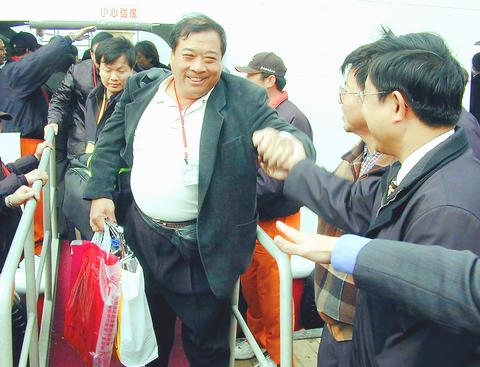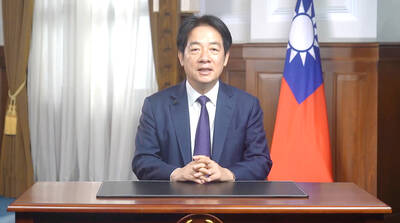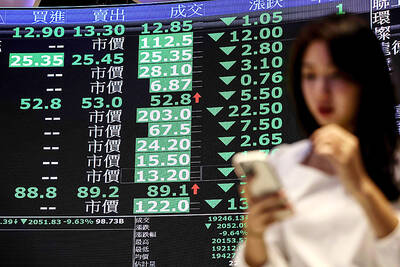A group of China-based Taiwanese businesspeople and their relatives were ferried directly from the Fujian Province port city of Xiamen to the outlying island of Kinmen yesterday, on the first leg of their journeys back to Taiwan for the Lunar New Year holidays.
The voyage of the 181 Taiwan citizens aboard the Kinmen-based ferry Tai Wu marked the first government-approved direct transportation of people, rather than goods, from China to Taiwan, following the government's initiation of the "small three links" on Jan. 2.
The links allow for direct trade, postal and shipping operations between Taiwan's outlying islands of Kinmen and Matsu and the mainland port cities of Xiamen and Fuzhou in Fujian Province.

PHOTO: WU SHI-TING, TAIPEI TIMES
Upon their arrival at Kinmen's Shuitou port, the Taiwanese passengers, most of them members of the Taiwan Investment and Business Association in Xiamen, were warmly greeted by Kinmen County Commissioner Lee Chu-feng (
All the passengers said they were thrilled with the trip, not only because the voyage was the first of its kind, but also because it saved them a lot of time and money.
The direct Xiamen-Kinmen-Taiwan sea and air trip will save roughly NT$10,000 for each person per trip. In the past, a traveler had to spend about NT$16,000 for a one-way trip to Fujian Province from Taiwan via a "third place," namely Hong Kong or Macau.
Sailing from Xiamen to Kinmen takes about 90 minutes. And a flight from Kinmen to Taipei takes about 50 minutes.
Chen Kuan-ting (
Kinmen County Commissioner Lee expressed the hope that the direct Xiamen-Kinmen-Taiwan trip formula, a "tentative arrangement" as labeled by the MAC, will turn out to be popular and successful and will eventually persuade the government to make it a fixed policy.
Huang Tieh-jung (黃鐵榮), chairman of the Taiwan Investment and Business Association in Xiamen, who was among the group, said now that both Taiwan and China are full members of the WTO, it is both sides' duty to further strengthen business and trade exchanges across the Taiwan Strait.
He added that he hopes that the Xiamen-Kinmen-Taiwan trip formula will become a fixed policy and that the Taiwan government will eventually turn the Xiamen-Kinmen passenger ferries into a regular service to make people exchanges between the two sides much more convenient and cost efficient.
The second group of its kind, which will include 115 Xiamen-based Taiwanese business people and their relatives, is scheduled to depart from Xiamen today for Kinmen, from where the group members are also expected to fly to Taiwan the same day for the Lunar New Year holidays.
The same group of travelers are scheduled to return to Fujian Province later in the month by taking similar ferries from Kinmen on Feb. 16, 17 and 24 to return to work in China after the holiday break.
Meanwhile, the Kinmen County government is planning to establish a school exclusively for children of China-based Taiwanese businesspeople to further serve the special group of people and their dependents, according to Lee.

ACTION PLAN: Taiwan would expand procurement from the US and encourage more companies to invest in the US to deepen bilateral cooperation, Lai said The government would not impose reciprocal tariffs in retaliation against US levies, President William Lai (賴清德) said yesterday, as he announced five strategies to address the issue, including pledging to increase Taiwanese companies’ investments in the US. Lai has in the past few days met with administrative and national security officials, as well as representatives from various industries, to explore countermeasures after US President Donald Trump on Wednesday last week announced a 32 percent duty on Taiwanese imports. In a video released yesterday evening, Lai said that Taiwan would not retaliate against the US with higher tariffs and Taiwanese companies’ commitments to

Intelligence agents have recorded 510,000 instances of “controversial information” being spread online by the Chinese Communist Party (CCP) so far this year, the National Security Bureau (NSB) said in a report yesterday, as it warned of artificial intelligence (AI) being employed to generate destabilizing misinformation. The bureau submitted a written report to the Legislative Yuan in preparation for National Security Bureau Director-General Tsai Ming-yen’s (蔡明彥) appearance before the Foreign Affairs and National Defense Committee today. The CCP has been using cognitive warfare to divide Taiwanese society by commenting on controversial issues such as Taiwan Semiconductor Manufacturing Co’s (TSMC, 台積電) investments in the

HELPING HAND: The steering committee of the National Stabilization Fund is expected to hold a meeting to discuss how and when to utilize the fund to help buffer the sell-off The TAIEX plunged 2,065.87 points, or 9.7 percent, to close at 19,232.35 yesterday, the highest single-day percentage loss on record, as investors braced for US President Donald Trump’s tariffs after an extended holiday weekend. Amid the pessimistic atmosphere, 945 listed companies led by large-cap stocks — including Taiwan Semiconductor Manufacturing Co (TSMC, 台積電), Hon Hai Precision Industry Co (鴻海精密) and Largan Precision Co (大立光) — fell by the daily maximum of 10 percent at the close, Taiwan Stock Exchange data showed. The number of listed companies ending limit-down set a new record, the exchange said. The TAIEX plunged by daily maxiumu in just

‘COMPREHENSIVE PLAN’: Lin Chia-lung said that the government was ready to talk about a variety of issues, including investment in and purchases from the US The National Stabilization Fund (NSF) yesterday announced that it would step in to staunch stock market losses for the ninth time in the nation’s history. An NSF board meeting, originally scheduled for Monday next week, was moved to yesterday after stocks plummeted in the wake of US President Donald Trump’s announcement of 32 percent tariffs on Taiwan on Wednesday last week. Board members voted to support the stock market with the NT$500 billion (US$15.15 billion) fund, with injections of funds to begin as soon as today. The NSF in 2000 injected NT$120 billion to stabilize stocks, the most ever. The lowest amount it